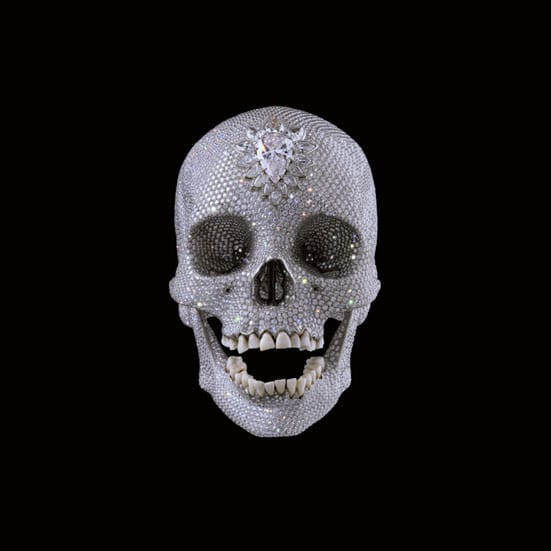1st June 2007 — 7th July 2007
Spanning
Jay Jopling's twinned Cubes, Beyond Belief provides the most complete
testimony to Hirst's oeuvre yet - an array of examples from each method
of his practice, culminating in what could be described as equal parts
paradigmatic and guilty confessional of Hirst's ideology.
At Hoxton Square it's business as usual: animals lurk in tanks
of formaldehyde, hobbled into divine poses; and waxy, lifeless realist
paintings hang upstairs, this time more autobiographies than autopsies.
Accompanying these is evidence of Hirst's latest disciplinary
appropriation: vast screen-prints of electro-magnified diseases
entitled with characteristically blunt, medical gratuity. Sprinkled
over the surface of these prints are, variously, shards of glass,
scalpels, razor blades, and catholic trinkets. Grand and familiar
themes abound here - life, death (the fear of both), man's meddling in
God's domain - but the new screen prints add little to the canon. In
fact, the pieces on display predominantly describe cold reiteration,
both visually and conceptually. Hirst's reappraisal of notoriously
fecund periods of his artistic life continues at Mason's Yard, and is
exemplified by Death Explained. The fabled shark is back, this time
halved and displayed in two separate tanks so we might read its
unintelligible innards for answers. Of course, like us, Hirst is none
the wiser - still confounded by God's immutable benignancy - but he is
certainly, willingly, concessionary.
Upstairs in the ticketed, guarded bowels of The Cube, is the divine
nucleus of the exhibition. In the centre of a darkened room, on a
velveteen plinth and behind glass, is a human skull cast in platinum
and encrusted with 8,601 diamonds. The piece is worth £50,000,000 and,
perhaps consequently, each group of visitors has a miserly two minutes
with it. As I entered the room with my allotted group we voicelessly
established a democratic procession around the exhibit. I stared at
every bejewelled orifice, every hammered-platinum hem, every whorled,
diamond lobe. Its price precedes any critical gaze passing over its
coruscating surface.
It's been evident for some time that Hirst has become a juggernaut of
self-generating commerce, able to plough through even the sternest of
criticism on his way to economic nirvana. In the retroactive context of
For the Love of God, the entire exhibition seems an overtly cynical
artistic exercise. There is little attempt to sweeten the embittered
financial spring that irrigates these collected pieces; it seems as if
Hirst has stopped his smirking and become seriously, determinedly
greedy. It seems his ultimate understanding of power as determined
through money, and its cynical blossoming within an explicitly
capitalist art-world, is the requisite reading of this exhibition.
Hirst has flirted with this profession before, but previously tempered
it with a sort of he-who-dares spirit; his success ascribed to his
confidence in making bold, brash statements without regret,
consultation or modesty. The pseudo-profundity laboriously expounded in
his titles always felt self-consciously elaborate; he knew the
fallibility in such pomposity, empathising through sleight humour. In
contrast, his demonstrative titles in Beyond Belief deliver nothing but
bored puns. There is something telling about his emphatic verbosity to
support the pieces themselves; to prescribe the supposedly serious
narrative his work seeks but cannot supply. For the Love of God
epitomises this tendency. It provides plain and direct access to the
conversations the piece might offer - crude religiosity, greed, a
cynical appropriation of the public's inevitable reaction, and an
erroneous reliance on puns to provide theoretical heft. Any other
complexity that might be explored through actual contact with the piece
- such as the astonishing performance surrounding it - is annulled,
leading you interminably to the sardonic wealth at its foundation.
Hirst's direct antecedent for this spectacle is the ancient Aztec skull
covered in a mosaic of emerald shards in The British Museum.
Strikingly, the principle difference between this relic (along with
other religious artefacts, particularly catholic reliquaries) and
Hirst's piece, is in imaginative aspiration. The edict of the Aztec
skull is one of transcendentalism - a description of desire at the
expense of material value. Conversely, Hirst's skull expresses a
process of capitalist profit motivation and conditional 'faith' in the
free market. Which, of course, could be a worthy antagonist to the
spiritual alternative - not to mention a confessional for the state of
the arts - if it were not for the fact that these asides are utterly
supplanted by the conceptual supremacy of money. Self-reflexivity and
symptomatic humility are sacrificed, martyred, with frightening
efficiency for acquiescence to money. The success of the centrepiece is
assured, and its statement, however cynical, creates its own truth. As
with each of the other pieces in this exhibition, there is a hermetic,
self-perpetuating logic in For the Love of God that represents
infallibility - Hirst's commercial deification - at the tragic expense
of genuinely progressive dialogue.
EA
White Cube - Mason's Yard
25-26 Mason's Yard
London SW1Y 6B
http://www.whitecube.com
Open
Tuesday-Saturday, 10am-6pm

Damien Hirst
For the Love of God
2007
Platinum, diamonds and human teeth
6 3/4 x 5 x 7 1/2 in. (17.1 x 12.7 x 19.1 cm)
(c) the artist
Photo: Prudence Cuming Associates Ltd
Courtesy Science Ltd and Jay Jopling/ White Cube (London)